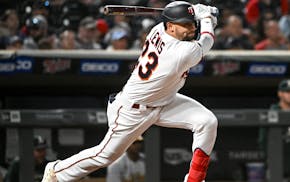It seems intuitive that a great defense is going to force a lot of turnovers. This is what makes the Vikings defense from last season so unique — it was one of the best units in the league while ranking 23rd in the NFL in takeaways.
But this isn't an anomaly for the Vikings under coach Mike Zimmer, especially when it comes to one of two ways you get a takeaway — causing and recovering fumbles.
According to data from the company Sportradar, the Vikings forced just eight fumbles last season, three from defensive end Everson Griffen. They recovered five of them.
Those eight forced fumbles were tied for 30th in the league.
If you go back over Zimmer's tenure in Minnesota you'll see the Vikings haven't forced a lot of fumbles compared to the rest of the league. They have caused only 41 since Zimmer arrived in 2014, again 30th in the NFL across that timespan. According to defensive end Brian Robison, this isn't a mistake.
"It does you no good to try and strip the ball but you don't have the tackle because if you don't get it out then he breaks off another 15 yards," Robison said.
What's interesting is the Vikings' rate of recovery on those 41 fumbles. They recovered 33 of them, or 80.5 percent, the second-best rate in the league and well above the league average of 65.9 percent.
There are certainly elements of hustle and athleticism involved in recovering a fumble, but it also requires luck — that an oval-shaped ball will bounce the right way once it hits the turf. The Vikings have been fortunate to get as many fumbles as they have.
They forced two in Saturday's preseason loss to the Jaguars but did not recover them. Defensive coordinator George Edwards said they Vikings had to work harder to get those kind of balls this season.
"Our biggest thing is we're causing fumbles, we're not necessarily getting the recovery," Edwards said. "That's one of the things we're working on, effort to the ball to try and improve upon this season.
Taken one way, the overall lack of forced fumbles is a positive for the Vikings in that the defense doesn't need them to be successful. It is able to stop opponents and limit their output without relying on turnovers and getting lucky in recovering loose balls.
"You have to try and secure the tackle first and foremost," Robison said. "And then it really comes down to once you secure the tackle, then you can try to make a play at the ball or the next guy coming in makes a play at the ball. It does you no good to run in there, try to punch a ball out or try to strip a ball when you don't have the tackle made."
You can pin the Vikings' defensive success on another metric since Zimmer arrived. Since 2014, the Vikings have leveled 401 hits on the quarterback, resulting in 162 sacks (sixth in the NFL).
"Our, D-line, we're trying to affect the quarterback," Robison said. "By that, we mean get him off his spot, basically if you have a pocket passer that you know is really good in the pocket throwing, get him off his spot. Hit him. Bat balls down. Things like that."
For the Vikings, the focus is always to put the player with the ball on the ground. If the ball happens to come out too, that's a bonus.
Chris Hine is the lead writer for North Score, the Star Tribune's sports analytics beat. startribune.com/northscore E-mail: chris.hine@startribune.com

![Vikings Terence Newman warms up during practice Thursday morning. ] BRIAN PETERSON • brian.peterson@startribune.com
Eden Prairie, MN 01/18/18](https://arc.stimg.co/startribunemedia/RCLKDCCJP7KX55YZTSR3XJWR6U.jpg?w=600&h=600&auto=format%2Ccompress&cs=tinysrgb)